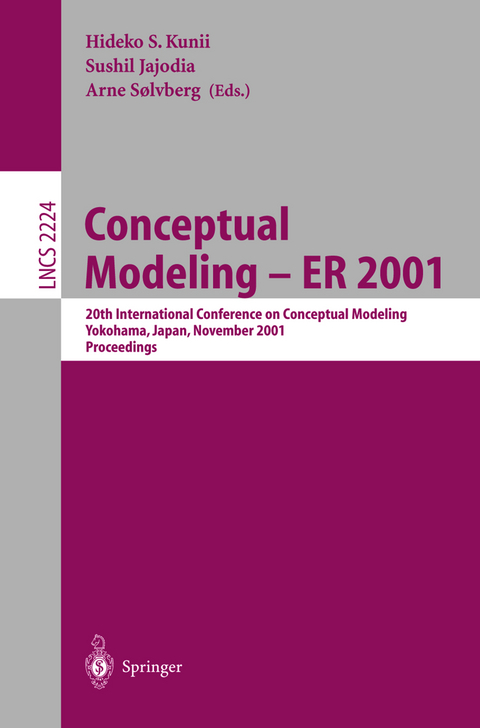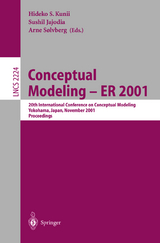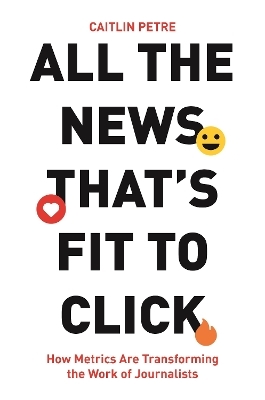Conceptual Modeling - ER 2001
Springer Berlin (Verlag)
978-3-540-42866-4 (ISBN)
The 45 revised full papers presented together with three keynote presentations were carefully reviewed and selected from a total of 197 submissions. The papers are organized in topical sections on spatial databases, spatio-temporal databases, XML, information modeling, database design, data integration, data warehouse, UML, conceptual models, systems design, method reengineering and video databases, workflows, web information systems, applications, and software engineering.
Keynote.- Conceptual Modeling for Collaborative E-business Processes.- "i-mode", Now & Future.- The Role of Research in the New Economy.- Panel.- Semantic B2B Integration: Is Modeling the Superior Approach over Programming?.- Spatial Database.- Modeling Topological Constraints in Spatial Part-Whole Relationships.- Source Description-Based Approach for the Modeling of Spatial Information Integration.- Topological Relationships of Complex Points and Complex Regions.- Spatial and Temporal Databases.- DISTIL: A Design Support Environment for Conceptual Modeling of Spatio-temporal Requirements.- Tripod: A Comprehensive Model for Spatial and Aspatial Historical Objects.- A Design of Topological Predicates for Complex Crisp and Fuzzy Regions.- XML.- A Semantic Approach to XML-based Data Integration.- A Rule-Based Conversion of a DTD to a Conceptual Schema.- Semantic Data Modeling Using XML Schemas.- Information Modeling.- Modelling Strategic Actor Relationships to Support Intellectual Property Management.- SiteLang: Conceptual Modeling of Internet Sites.- A Frame Work for Modeling Electronic Contracts.- Database Design.- CASE Tool Support for Temporal Database Design.- Domain-Specific Metadata a Key for Building Semantically-Rich Schema Models.- Coping with Inconsistent Constraint Specifications.- Data Integration.- Integration of Biological Data and Quality-Driven Source Negotiation.- Accessing Data Integration Systems through Conceptual Schemas.- Resolving Conflicts and Handling Replication during Integration of Multiple Databases by Object Deputy Model.- Data Warehouse.- Efficient Execution of Range-Aggregate Queries in Data Warehouse Environments.- A Pragmatic Approach to Conceptual Modeling of OLAP Security.- A Randomized Approach for the Incremental Design of anEvolving Data Warehouse.- UML.- Semantics of Stereotypes for Type Specification in UML: Theory and Practice.- Towards Ontologically Based Semantics for UML Constructs.- Developing Sequence Diagrams in UML.- Conceptual Models.- Translation of a High-Level Temporal Model into Lower Level Models: Impact of Modelling at Different Description Levels.- Relationship Type Refinement in Conceptual Models with Multiple Classification.- A Metamodel for Part ñ Whole Relationships for Reasoning on Missing Parts and Reconstruction.- System Design.- Developing XML Documents with Guaranteed "Good" Properties.- Dimension Hierarchies Design from UML Generalizations and Aggregations.- Minimize Mark-Up! Natural Writing Should Guide the Design of Textual Modeling Frontends.- Method Reengineering and Video Databases.- An Approach for Method Reengineering.- Modeling and Structuring Multiple Perspective Video for Browsing.- Modeling Dynamic Objects in Video Databases: A Logic Based Approach.- Workflows.- Pockets of Flexibility in Workflow Specification.- Agent-Oriented Enterprise Modeling Based on Business Rules.- A Three-Layer Model for Workflow Semantic Recovery in an Object-Oriented Environment.- Web Information System.- Recognizing Ontology-Applicable Multiple-Record Web Documents.- Querying Web Information Systems.- A Conceptual Modelling Framework for Standards-Driven Web-Based Distance Learning.- Applications.- XML-schema Dynamic Mapped Multimedia Content Description Tool.- Constructing a Data Map of Korea Telecom.- Competency of Set Analysis in CRM Closed Loop Marketing.- Software Engineering.- XML-based E2E Test Report Management.- A Framework for Reusing Business Objects by Multilevel Object Patterns.- A Mediation System Based on Universal Relation Modeling.
| Erscheint lt. Verlag | 14.11.2001 |
|---|---|
| Reihe/Serie | Lecture Notes in Computer Science |
| Zusatzinfo | XX, 620 p. 212 illus., 4 illus. in color. |
| Verlagsort | Berlin |
| Sprache | englisch |
| Maße | 155 x 235 mm |
| Gewicht | 1070 g |
| Themenwelt | Informatik ► Theorie / Studium ► Algorithmen |
| Schlagworte | conceptual modeling • Database • Database Design • Database Modeling • data engineering • Data Warehouse • E-Business • Entity-Relationship Model • Information Systems Design • Modeling • UML • unified modeling language (UML) • Video • Web-Based Information Systems • Workforce Management • XML |
| ISBN-10 | 3-540-42866-6 / 3540428666 |
| ISBN-13 | 978-3-540-42866-4 / 9783540428664 |
| Zustand | Neuware |
| Informationen gemäß Produktsicherheitsverordnung (GPSR) | |
| Haben Sie eine Frage zum Produkt? |
aus dem Bereich




